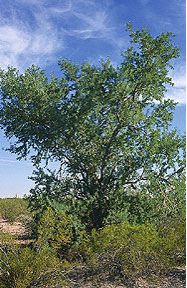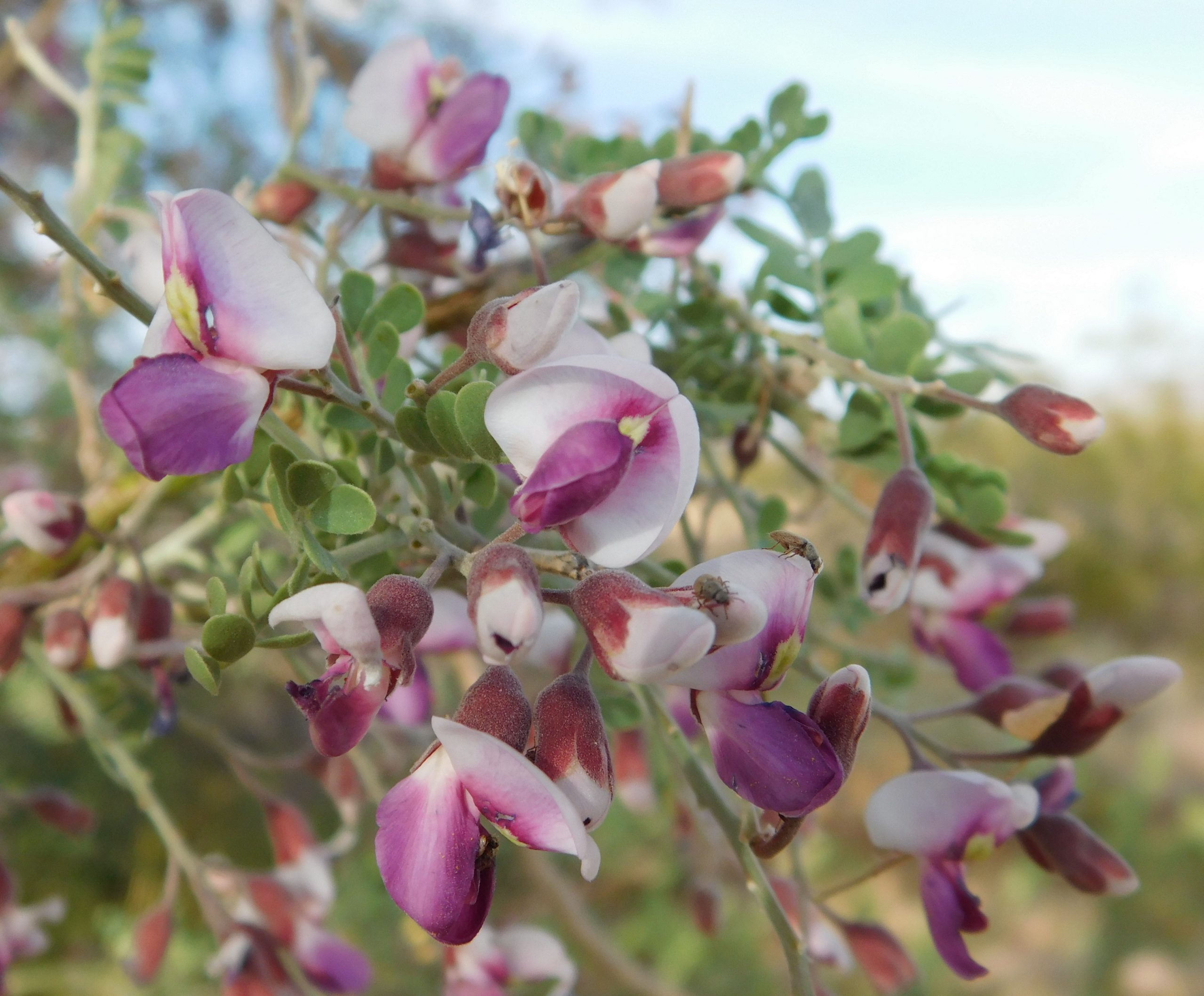Ironwood is a remarkable tree species found in the deserts of the American Southwest that possesses some unique properties, including its incredible density that makes it actually sink in water. This characteristic, along with ironwood’s other distinctive traits, makes it a fascinating plant worthy of appreciation.
The ironwood tree, with the scientific name Olneya tesota, is the only species in the Olneya genus. It is found in the Sonoran Desert region of the southwestern United States and northwestern Mexico. Other common names for this tree include desert ironwood, palo fierro, and tesota.
Ironwood trees can grow 20-50 feet tall and live an extraordinarily long time, with lifespans reaching 800-1,500 years. The trees have smooth, gray bark when young that becomes thick, shaggy, and deeply furrowed with age. The branching pattern is dense and intricate. Ironwood leaves are small, pale bluish-green, and doubly pinnate.
The trees bloom with dense clusters of purple, lavender, pink, or white pea-like flowers from May to June. These are followed by fuzzy brown seed pods about an inch long that contain several hard, shiny brown seeds.
What Makes Ironwood Sink in Water?
One of the most distinctive properties of ironwood is that it sinks in water, rather than floating like most woods. This is due to its incredible density.
Ironwood has one of the heaviest most dense woods in the entire world. The wood has been measured with a specific gravity of 1.04 to 1.15 (water’s is 1). For reference most woods have a specific gravity between 0.40-0.80.
This extreme density is possible because the wood is very hard and packed with thick-walled fibers. There are few air spaces or pores, giving it an almost uniform consistency. The density of ironwood makes it very difficult to cut or saw. It also gives the wood high fire resistance.
When a piece of ironwood is placed in water, the mass of the wood is greater than the displaced volume of water, so it cannot float. The dense wood rapidly sinks down instead No buoyant force can support it This unique sinking property sets ironwood apart from almost every other wood species.
Other Notable Traits of Ironwood
In addition to its incredible density causing it to sink, ironwood has numerous other noteworthy characteristics:
-
Slow growth: Ironwood trees grow very slowly, as little as 1 foot per decade. Their long lifespans are enabled by this slow growth pattern.
-
Extreme hardness: The wood is very hard and resistant to wear, abrasion, and decay. This makes it durable in harsh desert conditions.
-
Drought tolerance: Ironwood is well-adapted to the arid desert climate. It can withstand severe drought due to its deep root system.
-
Spines: Young branches are covered in sharp, woody spines that deter grazing by animals.
-
Nitrogen fixation: As a legume, ironwood forms symbiotic relationships with bacteria that fix nitrogen in the soil.
-
Nurse plant: Ironwood provides shade and protection for young saguaros, yuccas, and other desert plants growing under its canopy.
-
Wildlife value: Ironwood’s flowers provide nectar for bees and the seeds are eaten by birds and desert animals. The canopy offers shelter.
The Significance of Ironwood’s Sinking Property
Ironwood’s density that causes it to sink is key to its success thriving in the challenging desert environment. The wood’s hardness provides structural support for the tree’s large size and protects it from damage. It also makes the wood resistant to insect attacks.
Having dense, heavy wood enables ironwood to grow tall as a desert tree and provide ample shade—qualities that are integral to its ecological role as a nurse plant. Sinking ironwood also has cultural significance, as its weight made it useful for fence posts and building materials by desert dwellers.
Overall, the unique sinking property of ironwood wood serves as a reminder of the incredible adaptations plants can develop to prosper in their native habitats. It exemplifies the wonderful diversity and ingenuity found in nature.
So next time you are in the Sonoran Desert, keep an eye out for the distinctive ironwood with its hard, heavy wood that readily sinks in any pools of precious desert water. It is a testament to the marvels made possible by the patient, persistent power of evolution.
Ironwood as a Keystone Species and Nurse Plant
Ironwood is an example of a habitat-changing keystone species, which means that it has a big effect on where other species live and how many of them there are. Ironwood has a chain reaction effect on plants in the understory that help it grow. This effect changes how the plants spread, germinate, establish, grow, and reproduce. Scientists call these ecological dynamics “nurse plant ecology”. Mesquites and palo verde trees also do this, but the plants that grow in their “nurseries” are a little different from one another. Ironwood is the dominant nurse plant in some subregions of the Sonoran Desert.
As nurse plants, ironwoods shield seeds from harsh conditions and protect seedlings from freezes and extreme cold. They also shield saplings from extreme heat and radiation that can damage them. They also function as prey refugia, providing herbs and cacti protection from herbivores preying on vulnerable plant seedlings. Lastly, like other legumes, they change the mix of nutrients in the soil below their leaves, adding nitrogen and other nutrients.
Ironwood is often the tallest tree in its area, and birds and other animals that spread seeds like to roost in its branches, making a “rain” of seeds and whole fruit. The presence of ironwood and other legume trees can raise the number of bird species in desert scrub habitat by 663 percent. Germination rates are higher and seedling survival rates better due to the improved soil conditions. The shade and frost protection that ironwood’s canopy provides also help plants stay healthy, live, and grow. Thorny, low-sweeping branches keep out herbivores, promoting plant growth further. In turn, the wider range of plants grown in ironwood nurseries brings in a wider range of birds, both those that stay in the area and those that travel long distances.
The relationship between succulent cacti and ironwoods is especially well documented. Some new research shows that saguaro, organ pipe, and senita cactus would move many miles south to warmer, frost-free areas if desert legumes weren’t there to protect them. On cold nights, the ironwood canopies, where it may be 4o C warmer below than in nearby open areas, make all the difference for seedlings that are weak.
Ironwood plays a similar role in sheltering seedlings and saplings sensitive to extreme heat and radiation. Its canopy minimizes heat, damaging radiation, and water stress among plants established in its shade. When stripped of ironwood’s protective cover above them, some cacti actually suffer sunburn and die.
Not only does ironwood protect nursery plants from abiotic stresses like soil and water levels, it also protects them from some biotic stresses, especially those caused by herbivores. Large and small herbivores, like cows, rabbits, and rodents, are much less likely to eat seedlings when they are near thorny nurse plants. It’s not as strong in some places because a lot of animals nest, burrow, or hide under ironwood trees.
Ironwood as a Cultural Resource
People from the many native and ethnic groups that live in the Sonoran Desert have long valued ironwood for its ecological and cultural benefits. Traditional products and uses of ironwood include food, medicines, agricultural and household implements, and ceremonial and ritual uses. Most of these uses didn’t have much of an effect on ancient ironwood forests because they used either renewable resources (pods, seeds, flowers) or wood from already dead trees.
Most people know that Seri and Mexican carvers along the coast of Sonora use ironwood in their art. The Seri began to carve elegant, abstract renderings of native animals in the 1960’s. They always use dried, already dead ironwood. Nearby Mexican communities quickly copied the successful forms of the Seri carvings. But because they use machines, they can make carvings quickly, which is using up the ironwood in the area. Attempts to protect the ironwood forests in this area have so far been unsuccessful.
Because ironwood’s dense wood burns very hot, it is the most popular type of fuelwood in northern Mexico, where other types are hard to come by. Mesquite charcoal production for export to the U. S. consumes even more ironwood. Ironwood and mesquite trees grow together, and they are both illegally cut down. This is similar to how tuna nets kill dolphins and other species, though most of the time it is done on purpose rather than by accident.
Because Seri and others asked for it, the Mexican government now needs permits to cut ironwood, and no permits are given to cut ironwood for making charcoal. Though, it’s hard to make the laws stick, and poor woodcutters who get paid by the weight of wood they collect each day have a strong incentive to cut dense, heavy ironwood.
One thing that happens when people cut down trees in Mexico is that ironwood trees lose about 80% of their dominance in the areas that were studied. The demand for wood even sends Mexicans over the U. S. border to cut ironwood from Organ Pipe Cactus National Monument and other protected areas. Other changes are also threatening ironwood habitat on both sides of the border. For example, the fast growth of cities like Tucson, Yuma, Phoenix, Hermosillo, and Mexicali is breaking up ironwood habitat and turning it into farmland.
Grazing and competition by exotic species such as buffelgrass pose additional serious threats to ironwood. Buffelgrass, a popular forage grass for cattle, is highly invasive. Studies show that it lowers the number and variety of plant species in native plant communities and makes fires happen more often. Fueled by buffelgrass, these hot burning wildfires destroy ironwood and other trees and cactus. The huge increase in people living in the Sonoran Desert has caused more people to visit ironwood habitat, which is a threat.
Additional and fascinating information about desert ironwood trees can be found on the web site of the Arizona-Sonora Desert Museum as part of the Center for Sonoran Desert Studies.

Manganese in the water: Ironwood water investigation
FAQ
What does ironwood do rapidly in water?
What are the benefits of Ironwood?
Does Ironwood float in water?
What is the use of Ironwood?
Why are ironwood trees important?
Ironwood trees strongly influence the distribution and quantity of hundreds of wildlife species by functioning as a “nurse plant” and a “keystone species.” Canopies of mature trees provide microenvironments advantageous to understory plants, with winter temperatures several degrees warmer than open areas.
How much water do ironwood trees need?
Established ironwood trees don’t require much watering for healthy growth. Typically, you can give the tree around 1” (25 mm) of water per week, as long as the top layer of soil dries out between watering. However, ironwood trees are relatively drought-tolerant trees and will withstand periods of dry conditions.
Do desert ironwood trees need a lot of water?
Desert ironwood is a popular desert landscaping tree that provides light shade and interest to any yard, and needs little water after it’s established. The tree needs full sun and slight pruning to remove suckers and water sprouts (which can develop if the tree receives too much water).
Is Ironwood a hard wood?
Ironwood has one of the hardest woods of all the native North American trees. It’s harder than maple, white oak, hickory, elm, and birch trees. Because of this, the wood is used for making tool handles, fence posts, and mallets. Other common names for ironwood tree refer to the tree’s strength or growth features.

